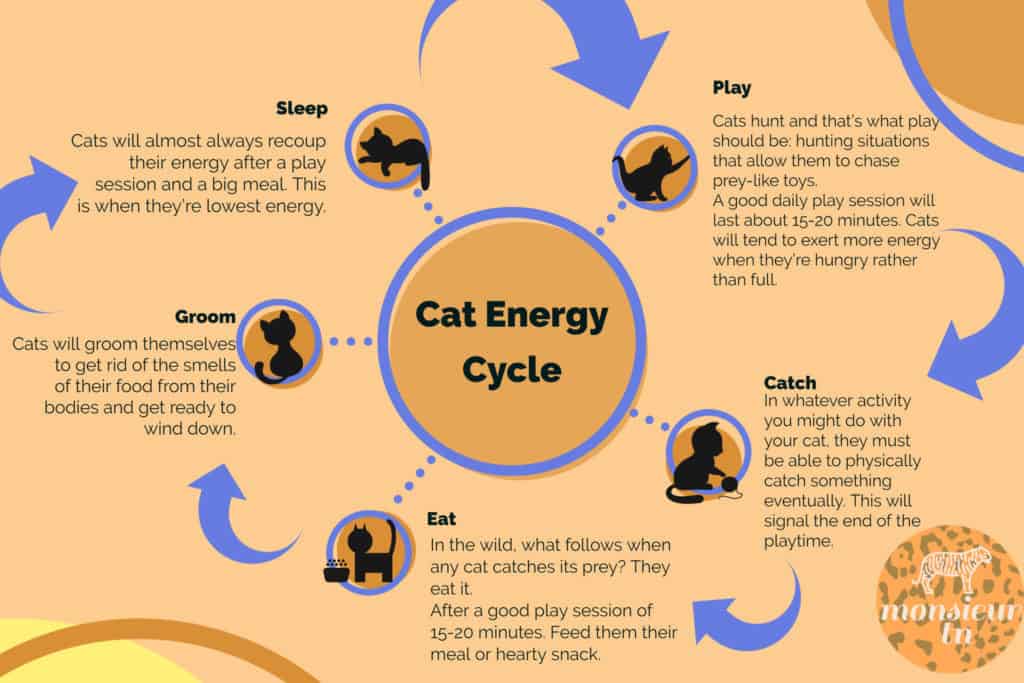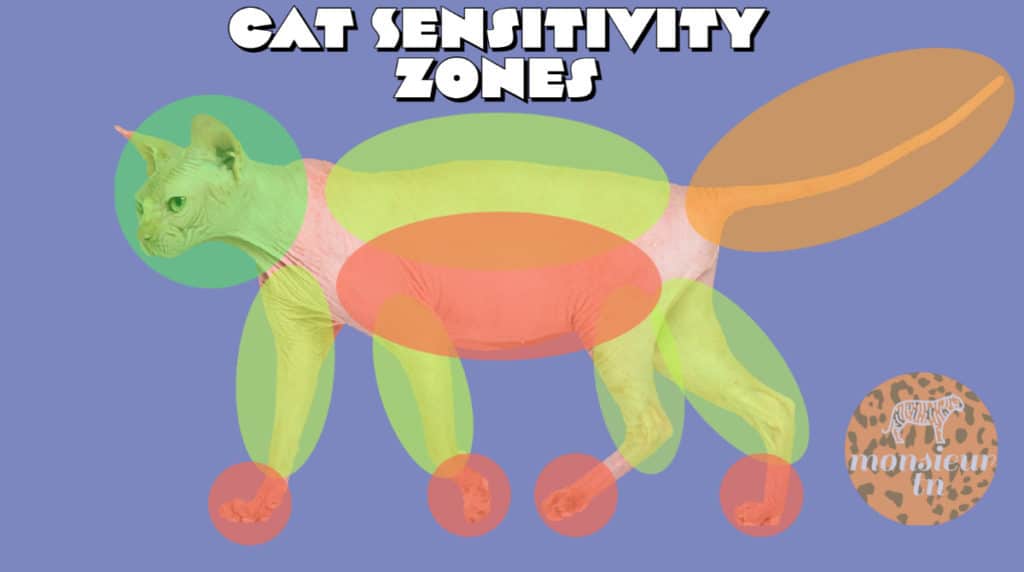If you’ve ever had the displeasure of trying to pet your cat and getting bit for your troubles, you’ll know how frustrating it can be. It’s hard not to take such a rejection personally, but it’s important to remember that the cat does not have any cruel intentions – they are simply behaving through instinct!

As with all animals and living things, cats have preferences that they want to be touched. Sometimes, that means no touching at all, much to their owner’s dismay – as they might growl, hiss, or even bite! If you’ve just adopted your first cat or you’re a new cat owner, there are definitely some things that you need to know before reading this (click through to read my comprehensive article)!
While there can be many reasons for this, most owners want to know how to help their cats be more accepting and tolerant of their touch. The best way to get your cat to tolerate touch and being pet is by taking a slow and deliberate approach to touch and implementing consistent strategies to begin to create a positive association with their owner’s hand. These strategies include leveraging food and the cat’s energy levels – in addition to being aware of how to touch your cat properly.
For biting problems specifically, I wrote a comprehensive guide that’s corrected all of the cats that I have implemented the strategies with. The strategies are similar to the ones below but contain additional methods for curbing biting behavior. Read: How to Stop a Cat From Biting!
Why a Cat Might Not Want to Be Touched
A cat might not want to be touched for a multitude of reasons. These are some of the most common reasons:
- Overly stressed – either because of drastic change (possibly in its environment or because a new animal was introduced).
- Illness or disease – an unhealthy or ill cat is usually a cat that feels chronic discomfort or pain. Therefore, not allowing them to relax, even though their environment is stable and comfortable.
- Hormonal reasons – if the cat is not neutered or spayed, hormones from its reproductive systems can wreak havoc on a cat’s behaviors which makes the cat unpredictable at times.
- Not properly socialized to accept human touch **
**If a cat owner has ruled out that the first three reasons are not an issue. It’s usually the last reason that is the most difficult since cat owners now have to figure out how to properly guide their cats to begin to tolerate and eventually enjoy being touched/pet.
The key to knowing how to touch a cat is to understand its body language. Cats will almost always convey their true intentions through their body language, so it’s vital to watch carefully.

If your cat is comfortable with you, they will display a wide range of positive body language. This will include relaxed, slow tail movements and calm, almost sleepy expressions.
If your cat is uncomfortable with you, they will display negative body language. This will include tense, jerky tail movements and an alert facial expression.
When Is the Best Time to Touch/Pet a Cat
There are going to be two times in which a cat is most tolerant of human interactions. The first is right after a large meal, and the second is after a really good play session.

1. Touch/Pet a Cat During or After a Meal
During a meal, most cats are going to have their full focus on the meal. Therefore, it’s the perfect time to desensitize cats to our touch and begin some positive associations. If you only touch them while they eat or after they eat, cats start associating the good feelings of food with a human’s touch.
In addition, when a cat has had a full meal, they’re usually very sleepy and lethargic. Since most cats are highly food motivated (click to read how food motivation affects your cat’s behavior), this means it’s a great time to use one of the approaches below to start to train them. This is why having set meal schedules is a great tool in modifying a cat’s behavior, in addition to managing your cat’s weight.
2. Touch/Pet a Cat After a Hearty Play Session
The second way is to tire them out through interactive play completely (click to see the most effective ways to tire out a cat). Similarly, if a cat lets out all of its predatory behaviors during a play session, it will likely be much less likely to respond in a way that’s aggressive and negative.
3. Combine Both For the Best Results
What’s better than 1. and 2.? Combine both and see double the effect. It completes their energy and instinctual cycles, which leads to more confident and well-adapted cats.
Proper Ways to Pet or Touch a Cat
Now that cat owners know when to touch their cat and when they’re the most tolerant, it’s also important to know how to touch a cat and what sort of ways are the most effective at training them to get used to human interaction.

Typically a cat will have zones that they feel most comfortable with touch and other zones in which maybe they get too stimulated or feels too sensitive to be touched (very high chance of either getting bit, swatted, or hissed at). It’s good to know how to approach these zones to allow them to better adapt to different sensations and ways of being touched.

With all of these approaches, it’s best to start by sitting or standing beside the cat and not directly in front – with a good amount of distance (one-step or scoot away) to allow the cat space. As your cat gets more comfortable with touch, owners can start to change their positions and distances.
Head-to-Bottom Approach
This is the most common way to introduce touch to a cat. However, it is also the most stimulating. If your cat is too stimulated (and still reacts negatively even after a few sessions) with this interaction, move onto the ‘side-to-side approach.’
- Get your hand as low as possible so as avoid going over the cat’s head.
- Start with a gentle touch on the forehead.
- Slowly move down to the neck towards the back.
- End around the base of the tail, as this is the region it starts getting overly sensitive for the cat.
- If the cat reacts negatively at any point, stop and start over from the head.
Don’t try to get all the way in the first session. Set goals for every session. Start with the cat being comfortable for being touched on the head. Then moving down to the neck region, to finally the back and base of the tail.
Side-to-Side Approach
This is the middle of the road in terms of stimulation for the cat. If the cat is still too stimulated and doesn’t exhibit any progress after a few sessions, move onto the ‘touch and walk away method.’
- Again, get your hand as low as possible to avoid going over the cat’s head.
- Start with one side of the cat’s cheek and move onto the other side.
- As they get more comfortable, move down to neck regions. Similarly, start with one side of the neck region and switch to the other side.
- In subsequent sessions, if the cat is showing progress, touch their back regions. Starting with one side and move to the other.
- If the cat exhibits any negative behavior at any point, stop and start over from the head.
In all these approaches – always keep an eye on their body language. More specifically, the cat’s tail. The more it moves, the more agitated it is, which is a sign of moving slower or being more gentle. If their tail is calmly moving around or still, the cat’s more comfortable, which means the owner can progress to more sensitive areas.
Touch and Walk Away Method
This is the least stimulating for the cat. Therefore, having the lowest likelihood of any negative reactions. Use this method if the cat isn’t responding well to the above two approaches.
This is the method that I used with my youngest cat, Loki, and my Bengal cat, Latte. They were both extremely sensitive and energetic when they were young. Even the slightest amount of stimulation and touch would get them in a fit of biting.
- Decide on a region or zone to target (usually the forehead/cheek region is best).
- Touch the cat in the target region before it can even get stimulated or react.
- Walk away.
Pretty much as the method describes, it involves quick interaction but walking away before the touching overstays its welcome. Increase the amount or length of time you touch each time and progress to different cat areas. Eventually, once the cat gets more comfortable – owners can decide on doing the head-to-bottom or side-to-side approach again.

We got our new adopted cat to come out of hiding. But then I thought the cat was comfortable with me, so I tried to pet her, but she ran under the couch again.
I hope she comes out again. Hope I didn’t scare her too much. Any suggestions
It’s great that your new cat is starting to come out of hiding! However, it’s important to remember that cats need time to adjust to new environments and people. It’s possible that your attempt to pet her was too soon and she wasn’t ready for that level of interaction yet.
To help your cat feel more comfortable, try to give her space and let her come to you on her own terms. You can sit near her hiding spot and read a book or work on your laptop, so she gets used to your presence without feeling threatened. You can also try to play with her using toys, as this can help build trust and positive associations with you.
When your cat does come out, try to avoid making direct eye contact or sudden movements, as this can be intimidating for cats. Instead, speak to her in a soft and calm voice and offer her treats or food to help build positive associations with you.
Remember, patience is key when it comes to helping your cat adjust to a new home. It may take days or even weeks for her to feel comfortable around you, but with time and patience, she will eventually come around.
**If you have any other questions, you can ask CatGPT 🙂 – he has access to the full knowledge-base of my website!
Use a toy to lure her out and play with her. Play with her often!
I fostered a set of 7 kittens and momma from 1 week old from the local animal shelter. I had Simon my bottle baby who I swore wouldn’t make it without intervention. Well even with all of that attention HE DOES NOT LIKE TO BE PETTED…. EVEN BY ME!!!! I don’t know what to do. I’ve been hand feeding him treats… that helps get him to come TO me… and when I see he’s NOT comfortable I’ll start suddenly tapping my hands everywhere instigating play with him…. yes I know not supposed to use hands as toys, but it’s the fastest way to redirect him from discomfort… to play mode… allowing me to stay close to him. I think he’s got some ptsd from health issues or lack of socialization. He seems SO WEAK AND FRAIL as a baby. He was 1/4 to 1/3 the size of his litter mates. His seemed SO WEAK!!! At first he couldn’t stand up on his back paws like a Prairiedog… but we worked on it slowly with toys getting him to practice his balance…. and finally after LOTS of work he could do it!!! Yay!!! I just want to be able to pet him like everyone else!!! He does sleep on me… sometimes within reach to pet which I FINALLY GOT HIM TO PUR… but only at night time when I wake up to find him pettable. Most of the time he still won’t have it. What do I do?! I did read through the article about getting kitty to be pettable and a lot of the strategies I did figure out, but what’s next?